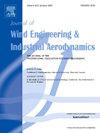基于压力跳变方法的多孔栅栏与地面固体障碍物气动相互作用的CWE研究
IF 4.9
2区 工程技术
Q1 ENGINEERING, CIVIL
Journal of Wind Engineering and Industrial Aerodynamics
Pub Date : 2025-08-14
DOI:10.1016/j.jweia.2025.106198
引用次数: 0
摘要
多孔栅栏被广泛用于减轻风对建筑和自然环境的影响。基于压力跳变(PJ)方法的计算风工程(CWE)模拟为早期设计提供了一种经济实用的工具,能够评估广泛的全球和本地工程性能指标。尽管PJ方法已经在风力工程的外部流动应用中得到了验证,但以前的研究通常集中在一组狭窄的性能指标上。本研究评估了PJ方法的能力,以预测广泛的工程指标,通过模拟多孔栅栏庇护名义上的二维三角形脊作为代表性案例研究。目的是评估PJ方法是否能够可靠地捕获与风蚀控制、风沙运输和风致载荷相关的性能指标。此外,该研究还研究了CWE模型,分别验证了多孔栅栏和脊的不同气动行为,是否可以准确地再现它们的气动相互作用。结果显示了很强的定性一致性,但揭示了定量准确性的局限性,特别是在近尾流区域,直接下风向的围栏。本文章由计算机程序翻译,如有差异,请以英文原文为准。
CWE study of the aerodynamic interaction between a porous fence and a ground-mounted solid obstacle via pressure jump approach
Porous fences are widely used to mitigate wind-induced effects on built and natural environments. Computational Wind Engineering (CWE) simulations based on Pressure Jump (PJ) approach offer a cost-effective and versatile tool for early-stage design, offering the capability to evaluate a broad spectrum of global and local engineering performance metrics. Although the PJ approach has been validated for external flows in wind engineering applications, previous studies have typically focused on a narrow set of performance metrics. This study evaluates the capability of the PJ method to predict a broad range of engineering metrics by modelling a porous fence sheltering a nominally two-dimensional triangular ridge as a representative case study. The objective is to assess whether the PJ approach can reliably capture performance metrics relevant to wind erosion control, windblown sand transport, and wind-induced loading. Additionally, the study investigates whether a CWE model, separately validated for the distinct aerodynamic behaviours of the porous fence and the ridge, can accurately reproduce their aerodynamic interaction. Results show strong qualitative agreement, but reveal limitations in quantitative accuracy, particularly in the near-wake region immediately downwind of the fence.
求助全文
通过发布文献求助,成功后即可免费获取论文全文。
去求助
来源期刊
CiteScore
8.90
自引率
22.90%
发文量
306
审稿时长
4.4 months
期刊介绍:
The objective of the journal is to provide a means for the publication and interchange of information, on an international basis, on all those aspects of wind engineering that are included in the activities of the International Association for Wind Engineering http://www.iawe.org/. These are: social and economic impact of wind effects; wind characteristics and structure, local wind environments, wind loads and structural response, diffusion, pollutant dispersion and matter transport, wind effects on building heat loss and ventilation, wind effects on transport systems, aerodynamic aspects of wind energy generation, and codification of wind effects.
Papers on these subjects describing full-scale measurements, wind-tunnel simulation studies, computational or theoretical methods are published, as well as papers dealing with the development of techniques and apparatus for wind engineering experiments.

 求助内容:
求助内容: 应助结果提醒方式:
应助结果提醒方式:


